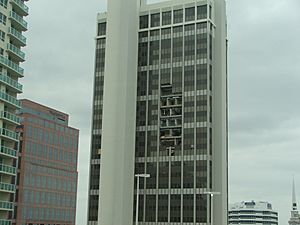One Financial Plaza (Fort Lauderdale) facts for kids
Quick facts for kids One Financial Plaza |
|
|---|---|
| General information | |
| Status | Complete |
| Type | Office |
| Location | 100 SE 3rd Ave, Fort Lauderdale, Florida,[United States |
| Coordinates | 26°07′18″N 080°08′24″W / 26.12167°N 80.14000°W |
| Construction started | 1972 |
| Completed | 1972 |
| Opening | 1972 |
| Height | |
| Roof | 374 ft (114 m) |
| Technical details | |
| Floor count | 28 |
| Floor area | 291,745 sq ft (27,104.0 m2) |
One Financial Plaza is a tall, 28-story building located in downtown Fort Lauderdale, Florida, USA. It opened its doors in 1972. When it was first built, it was the tallest building in the Fort Lauderdale area! Since then, other buildings have been built that are even taller. Today, it is the sixth tallest building in the city.
This building looks a lot like the Chase Tower in Amarillo, Texas. Both buildings were built around the same time. Chase Tower opened in 1971, just one year before One Financial Plaza. Chase Tower is only a little bit taller, with 31 stories.
History of One Financial Plaza
When the building was finished in 1972, it was first known as the Landmark Bank Building. This was because Landmark Bank built it and was its main tenant, meaning they used most of the space.
Changes in Bank Names
In 1985, Landmark Bank was bought by another bank called C&S. Over the years, C&S also joined with other banks. Eventually, it became part of a very large bank called Bank of America.
In 2002, Bank of America moved its offices to a different building nearby. The next year, a new bank called Union Planters Bank moved into One Financial Plaza. The name on the building was changed to "Union Planters." Later, in 2004, Union Planters Bank joined with Regions Bank. So, the building's name changed again to "Regions."
Surviving Hurricane Wilma
In 2005, a strong storm called Hurricane Wilma hit Fort Lauderdale. One Financial Plaza, like many other buildings in the city, was damaged. A large crack appeared on the side of the building, stretching from the 14th to the 19th floors.
After the hurricane, construction began to fix the damage. Workers rebuilt the outer walls using strong, storm-grade materials. This made the building safer and more modern. The repairs were finished in 2009. The company that fixed the building's outside walls was RLC Architects from Boca Raton.


